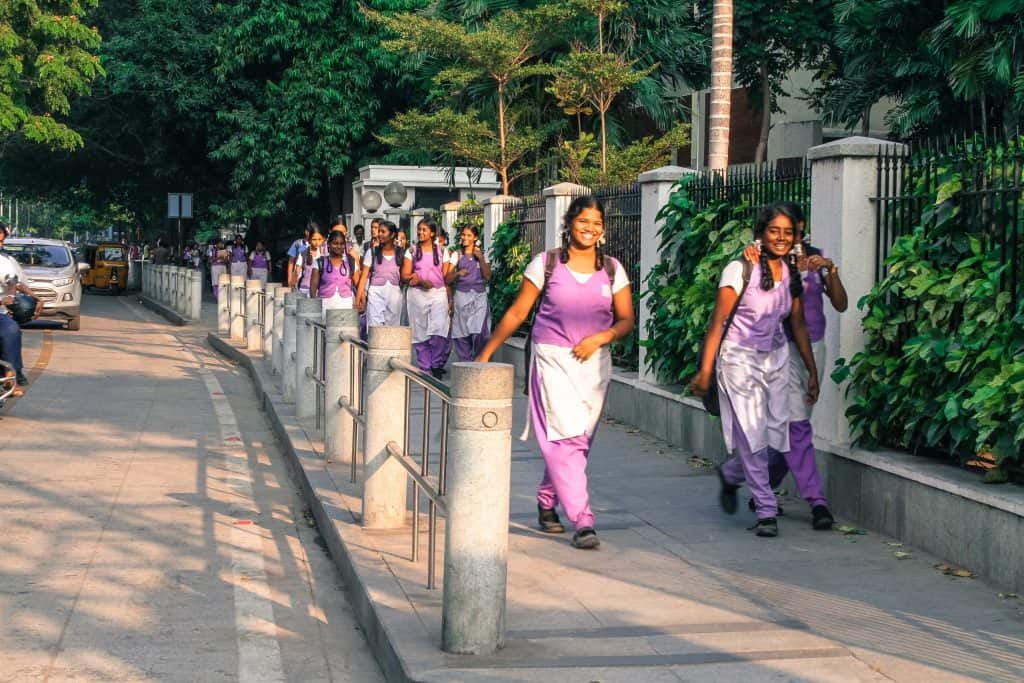Ever since the smart city project commenced in T Nagar, the area has been in the limelight. Organisations such as The Institute for Transportation and Development Policy (ITDP) have been working closely with Chennai Corporation and Chennai Smart City Limited, to understand the challenges particular to the locality, and propose sustainable mobility interventions.
In an interview with Citizen Matters Chennai, Aswathy Dilip, Senior Programme Manager at ITDP India talks about the Smart City projects and how they have the potential to propel T Nagar on to the league of international cities and neighbourhoods.
Ashwathy leads the Complete Streets strategy, policy and project work for ITDP, India. With support from her team, she works with the national, state and city governments, providing them technical assistance on sustainable and equitable urban mobility.
The state has been talking about a Non Motorised Transport (NMT) policy since 2014. Yet, we do not see much visible progress on this front. What is your take on it?
In 2014, Chennai was the first city in the country to adopt a policy that made walking and cycling — or non-motorised transport — its priority. The policy aimed to arrest the decline in walking and cycling in Chennai by creating a safe and pleasant network of footpaths and cycle tracks. It mandated that a minimum of 60 percent of the Corporation’s transport budget be allocated to construct and maintain NMT infrastructure.
Over the last four years, Chennai has been consistently working towards this goal. The city has built over a 100 km of ‘Complete Streets’ in Besant Nagar, Egmore and Harrington Road among others. These reclaimed roads now have wide and continuous footpaths, safe pedestrian crossings, carefully-located bus stops that enhance convenience, designated on-street parking, organised street vending, and properly-scaled carriageways. They not only cater to pedestrians and cyclists but are also designed to respond to the needs of children, women, elderly and specially challenged — all vulnerable road users — who were entirely ignored in the past.
This is a massive transformation. I doubt if there are other cities in the country that have reclaimed road space from more than 100 km of its streets to create safe and continuous footpaths. Yet there is a lot more to be done. To ensure that the entire city is safe, the remaining 300 km of streets belonging to the Corporation as well as the urban streets belonging to Highways should also be transformed as Complete Streets.
What were the main challenges faced over the last four years while implementing the NMT policy?
Changing the mindset of Corporation engineers was one of the most challenging tasks. For years, the engineers were designing roads as conduits for vehicles to move smoothly with a foot-wide path for pedestrians with trees, utility boxes, and bus stops further obstructing pedestrian movement.
To inspire engineers and show the impact of designing complete streets, various national and international study tours were organised. Further, to build their technical expertise on NMT user needs, design principles, planning, and implementation the Corporation initiated a technical training programme for Corporation engineers in collaboration with Anna University and ITDP. Four batches of approximately 20 engineers each have successfully graduated from this course.
After four years of continuous capacity building of various forms, it is heartening to see many engineers champion the needs of vulnerable road users while designing streets. This effort has to be continued in the future to ensure that the change is embedded deeply in the system.
Secondly, quality of street design and implementation have been a major concern. While some streets, such as Harrington road, were designed and implemented well, other streets had poor design and/or designs were lost in transition from paper to the ground. To tackle such issues, Chennai is on its way to adopt its own street design guidelines. ITDP is preparing the same in collaboration with the engineering team.
Chennai Smart City has hired a project monitoring agency to ensure that construction is as per design and of high quality. Over the next year, we will work with the Corporation to ensure the project monitoring expands to all the street design projects of the Corporation.
Encroachment of footpaths by parked vehicles and two wheelers is another major challenge.To address this issue, the Corporation is launching a progressive on-street parking management on all bus route roads covering 12000 parking slots. Effective enforcement of this system will be critical to ensure that footpaths are not used for parking.
The pedestrian plaza project has attracted considerable media coverage. Recently, there was some concern over trees being felled to make way for the plaza. How is the project addressing such concerns?
After the Vardah cyclone in 2016, the Corporation in collaboration with an environmental trust, Care Earth and Tamil Nadu Urban Infrastructure Financial Services Ltd conducted an in-depth study on conservation of biodiversity in Chennai.
This study, which included a detailed zone-wise mapping of green cover, also identified six existing trees in Pondy Bazaar as dead. The tree that fell during the pedestrian plaza implementation was one of the trees identified as dead. Further the other dead trees will also be cut during implementation to ensure that no harm is caused to street users.
The design of the pedestrian plaza also identifies 50 locations to add more trees. The officials have confirmed that 50 saplings will be planted as per design.
The removal of on-street parking at the pedestrian plaza has led to push back from local shopkeepers. What is the status of the Multi Level Car Parking (MLCP) that was proposed at the end of the plaza? How do you see the MLCP easing issues in the area?
The pedestrian plaza at T Nagar is envisioned as an attractive public space for shoppers with wide and continuous pedestrian walkways, ample opportunity for seating, comfortable tree cover, and colourful play elements. Once implemented, only two wheelers and public transport will be allowed between Panagal Park and Thanikachalam Road.
On-street parking has been removed from this stretch and proposed to be located at the multi-level car park planned at the junction of Thanikachalam Road and Theyagaraya Road. This project has been slightly delayed. The project is proposed to be constructed with new technology, which is said to be causing the delay.
However, T Nagar is a neighbourhood with a fine network of streets and small blocks. A quick study of the area by ITDP showed that there is enough parking slots on the perpendicular side streets for shoppers to park. Surveys of shoppers at T Nagar have shown that more than half the shoppers already park on the side streets or at the parking space available along Panagal park. Most shoppers who park their vehicles on Theyagaraya road now are happy to shift to the MLCP in exchange for high quality public space.
A lot of residents from T Nagar are relocating to other localities, complaining of an array of civic issues including pollution and traffic gridlocks. Do you think the situation will change in the next five years?
T Nagar was Chennai’s most attractive destination for local residents as well as tourists. Unfortunately, the transport system and street management practices in the area had failed to keep up with growing retail demand, and led to a deterioration in quality of life in the neighbourhood. Over the years, the area suffered a steady takeover by vehicles leading to increased congestion, noise and air pollution as well as parking problems. This could be the reason that residents are shifting from the neighbourhood.
Over the next five years, I imagine T Nagar transformed to regain its old glory and go beyond that. The pedestrianisation project will create a vibrant public space at the heart of T Nagar that will increase comfort for shoppers. Further the network of 25 km of arterial streets in T Nagar will be redesigned as Complete Streets, catering to the needs of all users. This will help discipline traffic flow in and out of T Nagar and calm traffic in the interior streets.
While these projects integrate landscape and increasing tree cover, all major parks of the neighbourhood have also been upgraded as a part of the Chennai Smart City mission. New trees on the streets and public spaces will provide shade, adding comfort to citizens visiting them.
The entire zone will soon have an IT based on-street parking management system that will enable shoppers to quickly find parking slots close to their destinations. Demand-based parking fees will prevent taxi drivers from occupying premium parking spaces for long. Strong enforcement will ensure that cars are not irresponsibly parked in front of residence gates or footpaths.
With such comprehensive transformation, the quality of life of all citizens — residents, traders, shoppers, and tourists — will improve dramatically.
Which other areas do you see as having similar potential? What kind of projects would you suggest for these?
As I mentioned before, the entire city should be safe for its residents. The city needs a complete streets master plan which identifies arterial streets that should be transformed into complete streets, streets along water bodies or parks that can be transformed into green ways, as well as key streets in each neighbourhood that can be transformed into pedestrian only/priority streets.This city-wide plan will help identify packages, estimate budget and in phasing for implementation.
All neighbourhoods have such potential. Streets represent the largest area of public space in all cities. Market areas and commercial streets, streets with schools and colleges as well as other important destinations such as transit stations attract a lot of pedestrian traffic. These streets when designed well can form the identity of the neighbourhood as well as increase safety and comfort of all its users. They can transform the way our citizens experience the city.


With no change whatsoever taking place in Streets abutting Usman Road, and in Usman Road, how can T Nagar be classified as Smart City? Further, how are they going to address the massive scale of encroachments on Ranganathan Street, Railway Border Road, service lanes of Usman Road? It is not enough making over a few places where there are no heavy movement of both pedestrians and vehicles. How are they going to address the widespread violation in the construction of buildings? How are they going to ensure that the commercial buildings that dot in and around Usman Road have fire safety mechanisms? Under the smart city mission, it is incumbent upon the authorities to ensure 24-hour water/power supply to T Nagar. How will they implement the same?